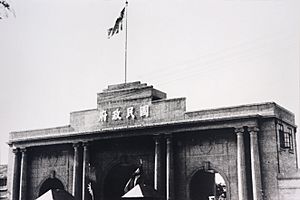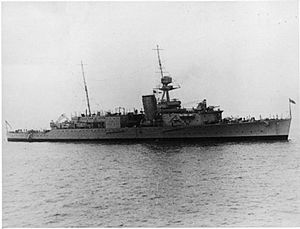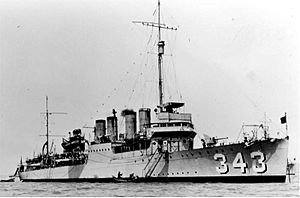Nanking incident of 1927 facts for kids
Quick facts for kids Nanking Incident |
|||||||
|---|---|---|---|---|---|---|---|
| Part of the Northern Expedition | |||||||
 The Nationalist capital building in Nanjing, 1927 |
|||||||
|
|||||||
| Belligerents | |||||||
| Commanders and leaders | |||||||
The Nanking Incident (Chinese: 南京事件; pinyin: Nánjīng ShìJiàn; Wade–Giles: Nan2-ching1 Shih4-Chien4) happened in March 1927. It was a time when the National Revolutionary Army (NRA) took over the city of Nanjing (then called Nanking) during their Northern Expedition. During this event, foreign warships fired on the city. They did this to protect foreign people living there from riots and looting.
Many ships from different countries were involved. These included ships from the Royal Navy (British navy) and the United States Navy. Soldiers called Marines and sailors also went ashore. They helped rescue people, including about 140 Dutch forces. Both Nationalist and Communist soldiers within the NRA took part in the riots. They also looted property owned by foreigners in Nanjing.
Contents
Why the Incident Happened
Nanjing was a treaty port in 1927. This meant it was a city where foreigners could live and trade. It was located on the southern side of the Yangtze River. This river is a huge waterway that divides northern and southern China.
Many foreign businesses in China were American and European. So, foreign navies kept ships along the Yangtze River. Their job was to protect their citizens who were doing business in these treaty ports. The British Royal Navy had its China Station there. The United States Navy had its Yangtze Patrol. Both of these patrols lasted for about 80 years, until World War II.
What Happened During the Incident
On March 23, 1927, the National Revolutionary Army (NRA) was quickly approaching Nanjing. The warlord Zhang Zongchang ordered his defeated troops to leave the city. Some of his soldiers could not get away in time. They deserted and started to loot foreign properties. They also attacked two foreigners.
Early on March 24, the NRA entered Nanjing without any fighting. They then went into the British, American, and Japanese consulates. They were looking for enemies. But they left peacefully when they found none.
Right after this, soldiers in uniform and local Chinese people started big riots. They attacked foreign interests. They burned houses and attacked the British, American, and Japanese consulates. They killed Dr. John Elias Williams, who was the American vice president of Nanking University. They also almost killed the Japanese consul.
The 6th Army of the NRA had many communist soldiers. They systematically looted the homes and businesses of foreign residents. One American, two Britons, one French citizen, an Italian, and one Japanese person were killed by Chinese soldiers. Chinese snipers also shot at the American consul and the marines protecting him. This forced them to run to "Socony Hill." This hill was named after property belonging to the Standard Oil Company of New York. American citizens were hiding there. During this chaos, one Chinese soldier said, "we don't want money, anyway, we want to kill."

Foreign Ships Respond
In response, the British navy quickly sent several ships towards Nanjing. These included the heavy cruiser HMS Vindictive and light cruisers like HMS Carlisle. Five American destroyers also went to Nanjing. These included USS Noa and William B. Preston. The Italian navy sent the gunboat Ermanno Carlotto.
At 3:38 pm, the NRA soldiers and Chinese rioters were driven away. This happened because of explosions and machine gun fire from the foreign warships. After the bombardment, foreign civilians hiding on Socony Hill were rescued. Sailors from the American ships Noa and Preston helped them. These two American ships fired 67 shells and thousands of rifle and machine gun rounds.
By the end of March 24, Nanjing was burning. It had bomb craters and people hurt from the fighting. Early the next morning, the USS William B. Preston was leaving. It was escorting a ship called SS Kungwo, which was full of people being evacuated. As the two ships started to leave, snipers on the riverbanks shot at Preston. The Americans fired back and stopped the attackers.
Three hours later, the two ships were sailing down the river. Preston was attacked again. This time, guns from a fort suddenly fired at them. Several shots missed, but one hit Preston's fire control platform. No one was hurt. The Americans fired back at the fort, and the Chinese guns stopped.
After giving Kungwo to the British, William B. Preston went back to Nanjing. Later, the Japanese sent gunboats. The Italians sent the gunboat Ermanno Carlotto. The Dutch sent the light cruiser Hr.Ms. Sumatra. The French sent the aviso La Marne. All these ships helped evacuate their citizens from Nanjing.
End of the Incident
By March 26, NRA commander Cheng Qian brought order back to Nanjing. He stopped his soldiers from attacking foreign forces. He also asked the Red Cross to help arrange a cease-fire with the foreign ships. On March 27, Preston left Nanjing with 70 more refugees.
By the end of that day, all fighting stopped. About 40 people were killed in total. One British sailor was killed, and one American sailor was hurt. American forces involved in the Nanking Incident received the Yangtze Service Medal. Three U.S. Navy signalmen also received the Navy Cross. They had kept communications going from a building's roof while under fire.
What Happened After
After the incident, the Nationalist Government said that soldiers who had left Zhang Zongchang's army started the attacks. They also blamed Communist soldiers within the NRA for bad actions. They said these actions were wrongly blamed on the Kuomintang.
The leader of the National Revolutionary Army, Chiang Kai-shek, thought that the Chinese Communist Party and Soviet advisors caused the Nanking Incident. He believed they used anti-foreign feelings to start the trouble. He suspected they wanted to make the communists stronger and hurt the Kuomintang. Because of this, the Nanking Incident helped him decide to remove the communists from the Kuomintang in Shanghai on April 12, 1927. This event formally ended their partnership and started the Chinese Civil War.
In 1928, Huang Fu, who was the foreign minister of the new Nationalist government in Nanjing, made agreements with the United States and Great Britain. They settled the damages caused by the Nanking Incident. The Kuomintang agreed to apologize and pay a lot of money to both countries. Even though the Kuomintang lost money, the Nationalist government gained something important. They received international recognition and started official diplomatic relationships with two major world powers for the first time after the Northern Expedition.
See also
- Pearl S. Buck
- Boxer Rebellion
- Hankou incident
- Jinan incident
- Tongzhou mutiny


